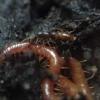Hey everyone!
I apologize for the unzoomed picture (Best the 5s could get), but I was wondering if you could help me ID these ants
Some Info: Found in a rotting pine log in Tidewater Virginia on a friend's hunting property, near an old rock quarry. I tried searching for other workers/brood but there only appeared to be these 4 ants huddled up against the queen. Species doesn't appear to have a stinger, or if they do they don't use it like Solenopsis richteri I encountered earlier that day. Workers are approx. 4mm and the queen looks to be in the 6-8mm range
Link: https://imgur.com/zQRfEPE
I believe I narrowed it down to :
Tetramorium caespitum
Myrmica punctiventris
Stenamma diecki
Aphaenogaster picea
Temnothorax longispinosus
But honestly at a certain point they all just appear to be small black ants to me, so I hope y'all can help me out!
(also I apologize, I can't figure out how to get the picture to show on this forum)
Edited by ComedyHotDog, April 3 2018 - 3:00 PM.

















